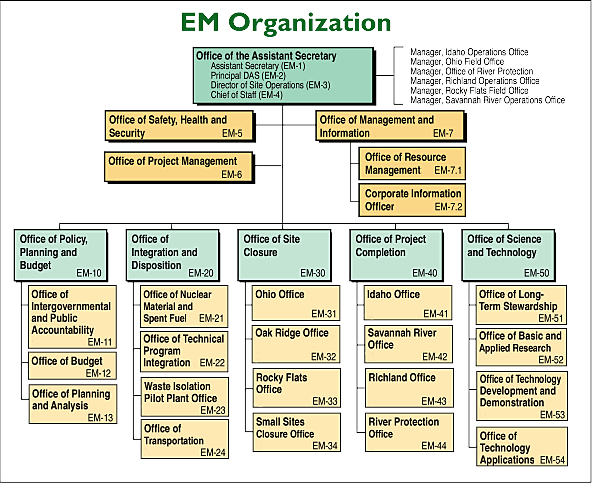
EM reorganization focuses on mission Soon after Dr. Carolyn Huntoon became DOE assistant secretary for the Office of Environmental Management (EM) in July 1999, she introduced six principles to guide EM’s large, complex, and costly environmental cleanup mission:
The principles are reflected in the reorganization she initiated, which is now in full swing. Among the changes is that "acting" was dropped from the titles of several deputy assistant secretaries (DASs) within EM, a move intended to give the individuals a sense of permanence in their positions and therefore greater responsibility and accountability. Site offices divided by categoryAnother significant aspect of the reorganization is that the offices formerly known as Waste Management (EM-30) and Environmental Restoration (EM-40) now reflect EM’s emphasis on ending cleanup operations at as many sites as possible by 2006 so the focus of cleanup efforts can turn to DOE’s most challenging cleanup needs. EM-30 is now known as the Office of Site Closure and oversees EM operations at the Ohio, Oak Ridge, and Rocky Flats offices as well as other, smaller sites. EM-40 is now the Office of Project Completion and includes the Idaho, Savannah River, Richland, and River Protection offices. James Fiore and Mark Frei were officially named as the deputy assistant secretaries of the two new offices, respectively. In keeping with EM’s first two guiding principles, Huntoon also established an Office of Safety, Health, and Security and an Office of Project Management. Other major offices within EM include the Office of Management and Information; the Office of Policy, Planning, and Budget; and the Office of Integration and Disposition.
Huntoon’s third guiding principle for EM highlights the important role for science and technology in environmental cleanup. The Office of Science and Technology (OST) retained its name and EM number (EM-50), but beyond that, much has changed within OST. First, OST gained a permanent DAS in Gerald Boyd. Boyd has been with OST almost since it began as the Office of Technology Development in FY90, and he had been the acting DAS since FY98. OST has also gained a new program. Highlighting the importance of EM’s fourth guiding principle and recognizing that the long-term stewardship of DOE sites requires advancements in science and technology, Huntoon placed the Office of Long-Term Stewardship within OST. See The Future is Now, EM's New Office of Long-Term Stewardship for information about this new program. Reorganization strengthens bridge to site customersOST is still organized along functional lines, with focus areas providing technology solutions to address major cleanup challenges, but the reorganization of EM-30 and EM-40 has provided OST an opportunity to also reach technology users through a site orientation. Site teams have been formed at EM headquarters to coordinate planning and budgeting support and oversight of cleanup activities at each site. In addition to EM-30 and EM-40 members, the site teams include representatives from OST and from EM-5, the Office of Safety, Health, and Security. In fact, with the recent placement of the Office of Long-Term Stewardship within OST, there are actually two OST representatives on each site team analyzing needs and providing information on near- and long-term technology solutions. Like their line program counterparts at the sites, the OST site team representatives connect problem holders with problem solvers. They help increase site awareness of technology demonstrations and deployments across the complex and communicate to the Environmental Management Science Program site needs that could be addressed through research programs. According to Boyd, OST is using its site team representatives to build a better bridge to the customer base, especially in the areas of planning and budgeting for current and future technology needs. In keeping with the walk-a-mile-in-my-shoes concept, OST has reassigned staff and altered reporting structures. These shifts were designed to help build an appreciation and understanding of the full breadth of activities required to maintain a strong and effective science and technology program.
|
